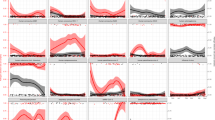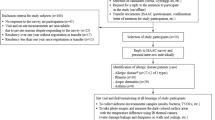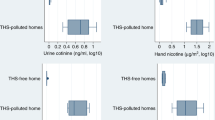Abstract
We used gas chromatography–tandem mass spectrometry to analyze microbial components in 85 samples of airborne dust from schools in Jordan, Sweden, and Poland. To collect the samples, we allowed dust to settle on plexiglass plates hanging in the breathing zone in school buildings during both summer and winter. In each of the three countries, we conducted such sampling in two schools: one in an urban environment and the other in rural surroundings. The microbial marker profiles differed significantly between the schools and seasons. For example, samples from Jordan contained remarkably low levels of ergosterol (marker of fungal biomass) and high levels of 3-hydroxy acids (markers of lipopolysaccharide) of 10, 12, and 14 carbon chain lengths relative to such acids of 16 and 18 carbons in comparison with samples from Sweden and Poland. This dissimilarity in 3-hydroxy fatty acid distribution indicates significant differences in the populations of Gram-negative bacteria. We also noted that muramic acid (marker of bacterial biomass) exhibited the smallest variation between schools and seasons. In summary, our results demonstrate that exposure to microorganisms in indoor air in school buildings may differ markedly between countries, between seasons, and between urban and rural environments.
This is a preview of subscription content, access via your institution
Access options
Subscribe to this journal
Receive 6 print issues and online access
$259.00 per year
only $43.17 per issue
Buy this article
- Purchase on Springer Link
- Instant access to full article PDF
Prices may be subject to local taxes which are calculated during checkout

Similar content being viewed by others
References
Bal K., and Larsson L. New and simple procedure for the determination of muramic acid in chemically complex environments by gas chromatography–ion trap tandem mass spectrometry. J Chromatogr B 2000: 738: 57–65.
Braun-Fahrländer C., Gassner M., Grize L., Neu U., Sennhauser F.H., Varonier H.S., Vuille J.C., and Wuthrich B. Prevalence of hay fever and allergic sensitization in farmer's children and their peers living in the same rural community. Clin Exp Allergy 1999: 29: 28–34.
Braun-Fahrländer C., Riedler J., Herz U., Eder W., Waser M., Grize L., Maisch S., Carr D., Gerlach F., Bufe A., Lauener R.P., Schierl R., Renz H., Nowak D., and von Mutius E. Environmental exposure to endotoxin and its relation to asthma in school-age children. N Engl J Med 2002: 347: 869–877.
Cookson B.T., Tyler A.N., and Goldman W.E. Primary structure of the peptidoglycan-derived tracheal cytotoxin of Bordetella pertussis. Biochemistry 1989: 28: 1744–1749.
Cookson J.B. Prevalence rates of asthma in developing countries and their comparison with those in Europe and North America. Chest 1987: 91: 97–103.
von Ehrenstein O.S., von Mutius E., Illi S., Baumann L., Bohm O., and von Kries R. Reduced risk of hay fever and asthma among children of farmers. Clin Exp Allergy 2000: 30: 187–193.
Hauschildt S., and Kleine B. Bacterial stimulators of macrophages. Int Rev Cytol 1995: 161: 263–331.
Haverinen U., Husman T., Toivola M., Suonketo J., Pentti M., Lindberg R., Leinonen J., Hyvarinen A., Meklin T., and Nevalainen A. An approach to management of critical indoor air problems in school buildings. Environ Health Perspect 1999: 107: 509–514.
Hesselmar B., Aberg N., Aberg B., Eriksson B., and Björksten B. Does early exposure to cat or dog protect against later allergy development? Clin Exp Allergy 1999: 29: 611–617.
Hines C.J., Milton D., Larsson L., Petersen M.R., Fisk W.J., and Mendell M.J. Characterization and variability of endotoxin and 3-hydroxy fatty acids in an office building during a particle intervention study. Indoor Air 2000: 10: 2–12.
Huttunen K., Hyvärinen A., Nevalainen A., Komulainen H., and Hirvonen M.R. Production of proinflammatory mediators by indoor air bacteria and fungal spores in mouse and human cell lines. Environ Health Perspect 2003: 111: 85–92.
McGuirk P., and Mills K.G. Pathogen-specific regulatory T cells provoke a shift in the Th1/Th2 paradigm in immunity to infectious diseases. Trends Immunol 2002: 23: 450–455.
Michel O., Kips J., Duchateau J., Vertongen F., Robert L., Collet H., Pauwels R., and Sergysels R. Severity of asthma is related to endotoxin in house dust. Am J Respir Crit Care Med 1996: 154: 641–646.
Mohamed N., Nǵanǵa L., Odhiambo J., Nyamwaya J., and Menzies R. Home environment and asthma in Kenyan school children: a case–control study. Thorax 1995: 50: 74–78.
Morey P. Comparison of airborne culturable fungi in moldy and non-moldy buildings. Proceedings of International Conference on Indoor Air Quality and Climate. Edinburgh, 1999, pp 524–528.
Park J.H., Gold D.R., Spiegelman D.L., Burge H.A., and Milton D. House dust endotoxin and wheeze in the first year of life. Am J Respir Crit Care Med 2001: 163: 322–328.
Riedler R, Eder W., Oberfeld G., and Schreuer M. Austrian children living on a farm have less hay fever, asthma and allergic sensitization. Clin Exp Allergy 2000: 30: 194–200.
Roponen M., Seuri M., Nevalainen A., and Hirvonen M.R. Fungal spores as such do not cause nasal inflammation in mold exposure. Inhal Toxicol 2002: 14: 541–549.
Saraf A., Larsson L., Burge H., and Milton D. Quantification of ergosterol and 3-hydroxy fatty acids in settled house dust by gas chromatography–mass spectrometry: comparison with fungal culture and determination of endotoxin by a limulus amebocyte lysate assay. Appl Environ Microbiol 1997: 63: 2554–2559.
Saraf A., Park J.H., Milton D., and Larsson L. Use of quadrupole GC-MS and ion trap GC–MS/MS for determining 3-hydroxy fatty acids in settled house dust: relation to endotoxin activity. J Environ Monit 1999: 1: 163–168.
Smedje G., and Norbäck D. Irritants and allergens at school in relation to furnishings and cleaning. Indoor Air 2001: 11: 127–133.
White D.C. Analysis of microorganisms in terms of quantity and activity in natural environments. In: Slater J.H., Whittenbury R., Wimpenny J.W.T. (Eds.). Microbes in their Natural Environments. Cambridge University Press, New York Society for General Microbiology Symposium, 1983: 34: 37–66.
Wilkinson S. Gram-negative bacteria. In: Ratledge C., Wilkinson S. (Eds.). Microbial Lipids. Academic Press, New York, 1988, pp. 299–488.
Zhiping W., Malmberg P., Larsson B.M., Larsson K., Larsson L., and Saraf A. Exposure to bacteria in swine-house dust and acute inflammatory reactions in humans. Am J Respir Crit Care Med 1996: 154: 1261–1266.
Zureik M., Neukirch C., Leynaert B., Liard R., Bousquet J., and Neukirch F. Sensitization to airborne molds and severity of asthma: cross sectional study from European Community respiratory health survey. BMJ 2002: 325: 1–7.
Acknowledgements
The financial support from FORMAS (Sweden) is gratefully acknowledged.
Author information
Authors and Affiliations
Corresponding author
Rights and permissions
About this article
Cite this article
Wady, L., Shehabi, A., Szponar, B. et al. Heterogeneity in microbial exposure in schools in Sweden, Poland and Jordan revealed by analysis of chemical markers. J Expo Sci Environ Epidemiol 14, 293–299 (2004). https://doi.org/10.1038/sj.jea.7500324
Received:
Accepted:
Published:
Issue Date:
DOI: https://doi.org/10.1038/sj.jea.7500324
Keywords
This article is cited by
-
Environmental DNA reveals diversity and abundance of Alternaria species in neighbouring heterogeneous landscapes in Worcester, UK
Aerobiologia (2022)
-
Muramic and dipicolinic acids in atmospheric particulate matter as biomarkers of bacteria and bacterial spores
Analytical and Bioanalytical Chemistry (2017)



